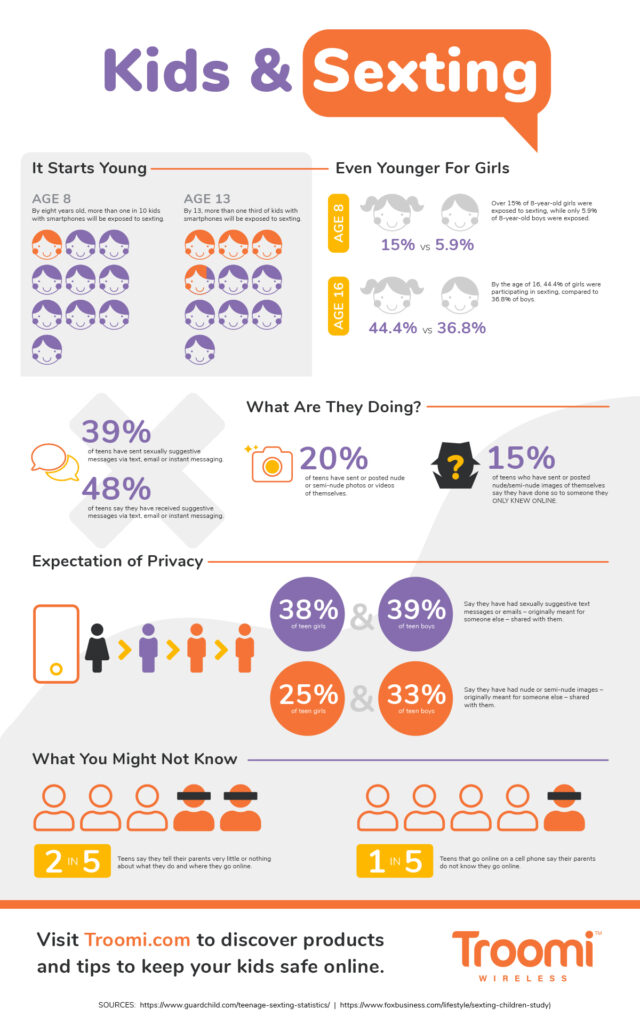
What is Sexting?
Sexting is sending sexually explicit (or suggestive) texts, photos, or videos. These can be sent via cell phone, computer, email, social media, or other digital devices. While sexting hasn’t been found to be widespread in teenagers, it is still a concern for parents. Guardchild found that one in ten children as young as eight years old have been exposed to sexting. Even with this concern, many parents don’t know the basics of sexting.
What do parents know about sexting?
In a survey conducted by NSPCC, they found that only half of parents were confident they would be able to access the right help for their teens who have sexted. And even then, only 42% of parents have talked about sexting with their child one time, and 19% never intend to talk to them about it. This lack of knowledge can be concerning. How can a parent teach their children about state sexting laws when 84% of parents haven’t reviewed the information? There is good news however: 50% of parents want to learn more—you being one of them.
So let’s learn some more together.
Let’s look at some sexting stats.
What amount of teens are actually participating in sexting? Jama Network performed a study in 2018 and found that 14.8% of teens were sending sexts and 27.4% were receiving sexts. Internet Matters.org has found in 2020 that “sexting is not widespread among all teens but is worryingly prevalent among those who are already vulnerable offline in other ways.” What does this mean?
The vulnerabilities studied ranged from speech difficulty to eating disorders to concerns about home life. They found vulnerable teens were more likely to share nudes, with 18% of teens who shared, pressured or blackmailed into it. They were bullied or harassed as a result of those images sent. Another at risk group were teens in long term relationships, who set aside Internet safety to share nudes with their significant other. They also found that less than 1/3 of those who did participate in sharing nudes followed any kind of Internet safety. Some never learned Internet safety at all.
Here’s what happened because they shared nudes.
- 17% had their image shared without consent
- 14% were bullied or harassed because of pictures/videos
- 14% were pressured to send even more
That study by Jama Networks also found that sexting occurs more frequently through cell phones than computers because of their portability and ease of communication. This study was completed in 2017, so it’s probable that number is higher still.
Why do Teenagers Sext?
There are a wide range of reasons that teens send sexts, from positive to negative. Teens might sext as a joke, to flirt, because of pressure, or even because of blackmail. Many might receive sexts and never respond. Some do send and aren’t aware of the consequences of their actions, and there can be serious consequences.
Dangers of Teen Sexting
For starters, there are a lot of risks to mental health by sexting. Teens who shared nudes are twice as likely to be cyberbullied compared to their peers who didn’t. The risks aren’t just online, like with all cyberbullying. Anxiety and depression as well as avoiding social situations like school or extracurricular activities can be a result of that cyberbullying.
More seriously, sexting is illegal for minors. Under state sexting laws, it’s illegal to send or receive explicit images of anyone under the age of 18. While you can’t prevent a typical phone from receiving texts, many state sexting laws have adjusted their wording to “receiving and keeping.” Deleting an explicit image may be enough to avoid a conviction. Even the effort to delete it shows good faith. Teens who send or have nude photos of themselves can be charged as adults with child pornography.
Penalties – There are a wide range of legal consequences because teen sexting can be tried in both adult and juvenile courts.
Teens – Juvenile penalties
Judges offer more leniency in juvenile cases, but teens can still be charged with serious offenses. It can be as light as a warning and as serious as detention (detention center, home confinement, group home, or another placement location).
Adult – Adult Penalties
Teens might be charged as adults if they are 18 or older and thus have more serious consequences. These can include incarceration, fines, probation, or even being added to a sex offender registry.
These are a few examples of very general, legal consequences for sexting for minors. Remember that some states have unique state sexting laws. Make sure you’re aware of the laws in your state.
What can you do to help your teen?
First, this is a difficult conversation to have with your teen but it’s critical. Teens need to know about the legal ramifications and other dangers of teen sexting. Even with that knowledge, teens and tweens might not come forward to alert you to sexting if they don’t feel safe talking with you. Many fear punishments or being a “snitch” in the eyes of their peers, but they still need adult help because of the complexity of the issue.
Katie Hurley at Psycom has outlined some excellent talking points to make this difficult conversation easier. While no one likes being lectured, especially teens, they need to learn before they make a decision that can have lasting consequences on their entire lives. Here are some of the basics to get you started.
- Talk about what kinds of content is safe to share online or over the phone. Remind them that things sent or posted are out of their control. Images and texts can be screenshot-ed or downloaded. The person who has received it now has control over that image.
- Let them know in advanced about state sexting laws and child pornography laws. While the consequences for adults are more serious, they can still have lasting ramifications on your child’s life.
- Help them with peer pressure. Give them excuses to help them avoid feeling trapped into sharing sexts. Vulnerable teens are more at risk of sending sexts so make sure you’re listening to their concerns and are actively involved in their lives.
- Most importantly, tell them what they should do if they ever do happen to receive a sext. While sexting isn’t rampant, there is still a chance a sext can be sent to your child’s phone. Even receiving a sext can have serious consequences. Because of the legal and emotional ramifications, teens need adult help. Make sure you are aware of your state’s sexting laws.
- Consider a Troomi phone. Troomi’s phones have built-in safety nets to keep your child safe from sexting. This includes Safelisting phone numbers (so only certain numbers that you’ve approved can contact their phone) and enabling/disabling media sharing. This layer of protection can give you peace of mind.
Above everything else, make sure your teen feels safe and comfortable coming to you about anything that’s happened on or offline. If they feel like they will be judged or punished for coming forward, they will likely avoid letting you know or even coming to you for help if things escalate into something more serious. Check out this article for more help on difficult conversations with your teens. Most teens won’t sext, but you should make sure your teen is informed and you’re ready if they do.

